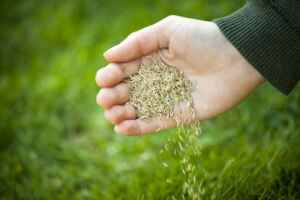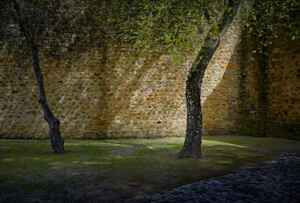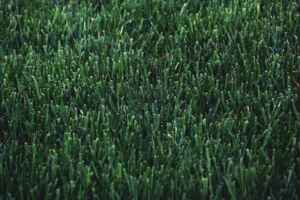Best Types of Grass for Shaded Areas
The type of grass you plant in your yard depends greatly on the amount of sun your yard receives daily. If you have a shaded yard, for instance, a grass type that requires high sunlight will not grow effectively.
So, what type of grass grows best in the shade? The best type of grass that grows in a shaded area is Fescue. Many others will do well in the shade as well as Fescue. When looking for new grass to plant in your yard, you may want to consider what type of light intensity it will get. Every house will receive different light exposures based on where the house is positioned. When choosing grasses to fit your yard needs, this is something to consider for a healthy lawn.
Keep reading for more tips on how to choose a type of grass that will grow well in your shaded yard!
When To Plant Your Grass
The best time to plant new grass is when there’s a temperature difference. If you live somewhere with cool and warm seasons, know which types of grass will grow better for your region’s climate conditions before planting! Cool-season grass thrives early spring through fall; it likes regions that range from 65 – 80 degrees Fahrenheit, such as Northern California or Pacific Northwest states like Oregon. Warmer season means increased temperatures between 75 – 90 degrees Fahrenheit, which would be optimal for more Southern states like Florida and South Carolina.
Types of Grass That Grow in Shaded Areas
 Some grasses perform better than others do in high and low light conditions, so we’ve created a list of grass types that are ranked by how well they perform in shaded areas:
Some grasses perform better than others do in high and low light conditions, so we’ve created a list of grass types that are ranked by how well they perform in shaded areas:
1. Perennial Ryegrass
Perennial Ryegrass prefers full sun but will tolerate some shade. The grass will do well if planted under large trees that receive afternoon shade. Perennial Ryegrass seeds germinate best at soil temperatures between 55 – 77 degrees Fahrenheit, which makes it one of the most used types of grasses for shaded areas.
2. Kentucky Bluegrass
Kentucky Bluegrass is a cool-season grass and will not tolerate warm soil or full sun, so it’s perfect for planting in areas that receive morning and afternoon shade. The grass can grow up to 3 inches tall which allows weeds to be controlled easily. For best results, wait until the soil temperatures are consistently above 60 degrees Fahrenheit to plant the Kentucky Bluegrass seeds for optimal growth.
3. Bermuda Grass
Bermuda Grass is a warm-season grass that likes full sun conditions but can still be planted under large trees with afternoon shade. This type of grass works great on slopes and hills because it does well in areas where water runoff can be controlled easily. Bermuda grass grows quickly, so make sure to plant your seeds early in the spring for optimal growth.
4. Fine Fescue
Fine Fescue prefers partial shade conditions but will do well with light shade as well. This type of fescue is mainly used on golf course fairways because of its low maintenance requirements and resistance. Like Kentucky Bluegrass, wait until the soils are consistently above 60 degrees Fahrenheit to plant your seeds.
5. Tall Fescue
The next type of fescue on our list is Tall Fescue, which also prefers partial shade conditions as Fine Fescue does. This variety of grass is great for high-traffic areas because it maintains its shape and won’t leave compacted footprints behind. Its quick growth allows it to be planted early in the spring, but you should make sure that an upcoming hot summer won’t cause excessive damage due to its low drought tolerance levels.
6. Zoysia Grass
 Zoysia Grass can take full sun conditions but does best if planted under large trees that receive afternoon shade. This grass tolerates drought conditions very well and can be mowed down shorter than most other grasses, which makes it perfect for lower maintenance areas like golf courses. Zoysia is slow-growing so make sure to plant your seeds early in the spring for optimal growth.
Zoysia Grass can take full sun conditions but does best if planted under large trees that receive afternoon shade. This grass tolerates drought conditions very well and can be mowed down shorter than most other grasses, which makes it perfect for lower maintenance areas like golf courses. Zoysia is slow-growing so make sure to plant your seeds early in the spring for optimal growth.
7. Buffalograss
Another type of grass that is perfect for high traffic areas is Buffalograss, which can take full sun but does best if planted under large trees with afternoon shade conditions. This grass is very drought resistant and grows in clumps, so it’s great to use on slopes or hills where water runoff can be controlled easily. It also has a low mowing height requirement at only 2 inches tall.
8. St. Augustine Grass
St. Augustine Grass prefers full sun conditions but will tolerate some shade as well. It’s mainly used for coastal landscaping due to its ability to withstand high salt concentrations, drought levels, and intense weather patterns without showing signs of stress or damage. Make sure you plant your St Augustine seeds early in the spring for the best results.
How Often Does Grass Need Water?
Grasses that grow well in shady areas will need water occasionally, but not as regularly as grasses that are planted in sunny locations. If you live in an area that is constantly dark and overcast, your grass will still need water.
These areas tend to be foggy and humid because the ocean or lake nearby creates dew and moist air throughout the day. Your grass will grow best if you water it every day for about half an hour, but remember that most types of grass do not need to be watered more than twice a week.
Should I Water My Lawn After I Fertilize?
If you fertilize your lawn, then you must water it afterward to help the nutrients spread throughout the soil. The fertilizer will not be as effective if it doesn’t have access to enough moisture, so make sure you water your lawn for approximately half an hour after applying fertilizer.
However, there are situations where watering your grass may not be enough because soil can restrict the nutrients from reaching your lawn. In this case, you should contact a professional landscaping company to help you out.
If you live in an area where drought conditions are common throughout the year, then it may be best for your grass health to skip fertilizing altogether until water levels return to normal. If you have sandy soil, then it will be more difficult for nutrients to travel into the root system.
What If My Lawn Has No Shade?
If your lawn doesn’t receive any shade throughout the day, you should plant Buffalograss or St Augustine Grass. These types of grass do well in full sun conditions. You can also purchase artificial turf to lay across your existing lawn area. This type of grass does well with direct sunlight exposure. Artificial turf can also be used on hillsides and slopes. It will not leave footprints behind from people walking on the grass, which makes it a great low-maintenance option.
For more information on all types of grass as well as artificial turf, contact your local city landscaping department or review our website to find a professional in your area who can assist.
What If My Shady Area Won’t Grow Grass?
 This means your soil does not have enough organic matter to support growth. It can be beneficial to add sand or compost into your soil before planting grass seed because this extra layer will help retain moisture and provide the nutrients that plants need to grow.
This means your soil does not have enough organic matter to support growth. It can be beneficial to add sand or compost into your soil before planting grass seed because this extra layer will help retain moisture and provide the nutrients that plants need to grow.
If you live in an area with wet soil conditions, then you should avoid fertilizing altogether because too much fertilizer will damage the plant roots and kill off growth.
It is important to know what type of grass grows in shade the best before deciding on a grass type for your lawn. Different plants need different amounts of light to grow well. Because of this, the amount of sunlight they get will determine how much work you have to put into them.
Lawns often need pruning and care throughout the year if they are receiving too little sunlight. Shade-loving grasses do not necessarily love complete darkness and tend to thrive when given about four hours of sun daily. If you’re looking to reduce the number of hours that sunlight hits your lawn, consider adding trees or shrubs into your landscaping design.
In Conclusion
Bermuda grass is a favorite type of grass to plant in the shade. It requires at least three to four hours of sunlight per day. However, if your yard does not receive this much sunlight, you can plant it in partial or full shade. Fertilize it to give the grass an extra boost and prevent yellowing or thinning leaves. Seedless grasses are gaining popularity, but they do need at least four hours of sunlight per day.
If you are not sure if your yard gets enough sun, you can always try planting and keep watch for a week to see how the grass responds. If it appears thin or begins to lose its color, then move the plant into more sunlight. Different types of grass require different types of treatment and care. Make sure when picking out your grass that you research to see which will be the best fit for you. As always, if you’re unsure which grass option will be best, contact a local lawn care professional for additional advice.

